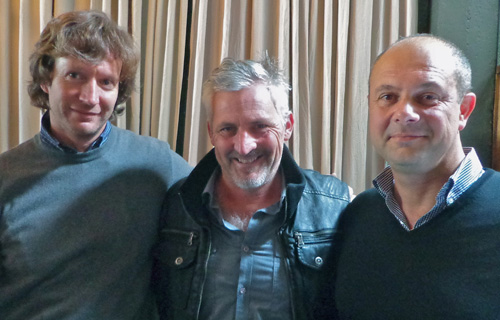
A Look at Italy’s Carso Orange Wines
By Kerry Winslow
Two of Italy’s star winemakers that not many have heard of visited San Francisco to show off their latest releases and chat about their historic region, the Carso in the Friuli-Venezia Giulia, which lies in Italy’s far Northeast close to the Slovenian border, in fact some of the vineyards straddle both sides. Benjamin Zidarich and Sandi Skerk, both hugely respected for their wines, are continuing a long tradition of organic farming and winemaking with a proud love of their land and region. This area has many historical influences and has ancient traditions and customs, one of which is “Orange” wine, this is white wine usually that sees long contact with the skins, that gives “Orange” wine it’s name. Most white wine the world over is made from just the juice of the grapes with little or no contact with the grape skins, though there are some adventurous winemakers trying out this ancient style of winemaking in California, Germany, Spain and Australia, though it is much more popular in Eastern Italy, Slovenia, Croatia and in the Caucacus, in places like the Republic of Georgia. The “Orange” wines are left on the skins, this is called maceration, and the amount of time on the skins varies depending on each wineries house style, some as little as 10 to 15 days and with some like Skerk that sees up to 40 days. The result of this long maceration is a more complex, and usually savory flavors more like red wines coming through, the wines tend to be tangy, spicy and exceptionally dry in character. While some wineries use Amphora to age “Orange” wine, neither Skerk or Zidarich employ ceramic vessels, they both use wood fermenters and age in cask or stainless, which might explain why both Skerk and Zidarich present such clean, fresh and elegant wines. My prior “Orange” experience has been mixed, and while I find skin contact white wines interesting and worth the exploration, there have been many disappointments, and some “Orange” wines can be oxidized, sherry like and volatile with dirty/muddy flavors, not so with Zidarich and Skerk, these are pretty and focused wines with elegance and vibrancy. Other serious and seriously good wines come from Kante and Radikon, that along with Skerk and Zidarich produce unique and complex world class wines. The new releases from both Shkerk and Zidarich are alluring and seductive wines, here are a few of my favorites, and I highly recommend checking these wines out, Viva la Orange!
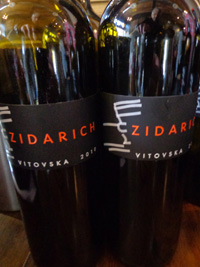 2010 Zidarich, Vitovska, Friuli-Venezia Giulia, Italy.
2010 Zidarich, Vitovska, Friuli-Venezia Giulia, Italy.
Made from the native Vitovska grape, the Zidarich 2010 shows bright grapefruit, melon and spiced pear, a light yellow hue and savory elements, this comes across austere and seriously dry, but it grows on you with time in the glass. The is an array of flavors that pop up, unexpectedly like cured meat, cheesy notes and there is a zest burst of acidity that adds kick to this white from Italy’s remote Northeast. A classic seafood white that is dusty dry and tangy fresh the Vitovska is a unique expression of grape, region and winemaking. Orange rind, lemon oil, verbena and soy notes come through after time in the glass.
($45 Est.) 87 Points, grapelive
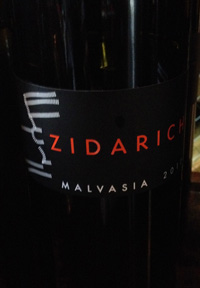 2011 Zidarich, Malvasia, Friuli-Venezia Giulia, Italy.
2011 Zidarich, Malvasia, Friuli-Venezia Giulia, Italy.
This Malvasia is golden/yellow with intense savory meaty layers, bright acidity, chalky minerals and tension filled dry fruits, dried apricot, pear, yellow canned peach, bacon oil, apple skin and orange rind. This vigorous white has loads of character and interesting elements, but needs time to come together. This Malvasia should potentially prove to be a seductive gem, though it is tight, powerful and somewhat severe at this stage. As an orange wine, the spice and savory side dominate and I’m certain with the right cuisine I’d come around to appreciate this well made white much more. The 2011 was much more interesting than the 2010 version, and Benjamin Zidarich explained 2010 was a tough and frightful vintage, while the 2011 looks set to be a classic in the region, though I noticed his wines seemed to need more time and thought to be as pleasing on the palate as I would like, give some time, I’ll be intrigued to re-visit this vintage in a few years.
($45 Est.) 90 Points, grapelive
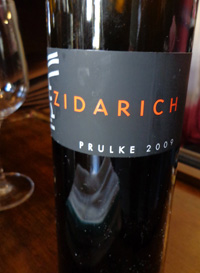 2009 Zidarich, Prulke, Friuli-Venezia Giulia, Italy.
2009 Zidarich, Prulke, Friuli-Venezia Giulia, Italy.
This intriguing white is made up of 60% Sauvignon Blanc, 20% Malvasia and 20% Vitovska, Zidarich’s Orange wine cuvee sees a long maceration, fermenting on the skins for at least 14 days, and this is the darkest hued wine in the stable, though not orange in color, but more golden and sunny in appearance. Benjamin Zidarich loves his Sauvignon Blanc vines and uses them to good effect here, but he says he’d never even consider not using it as part of a cuvee, keeping with ancient tradition to blend, and he feels it would take away from the sense of place he feels very proud of, he says a Sauvignon Blanc only wine would be more French that the Carso area. Regardless this wine is gorgeous and complex with lemon/lime, melon, peach, saline/iodyne notes, tangerine and kumquat. This was my favorite Zidarich wine and while generous on the palate it is brisk, spicy and finishes on the dry savory side, with perfect acidity and focus throughout.
($45 Est.) 94 Points, grapelive
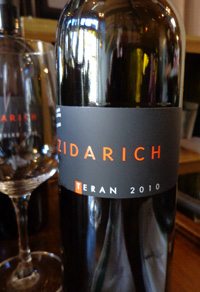 2010 Zidarich, Teran, Friuli-Venezia Giulia, Italy.
2010 Zidarich, Teran, Friuli-Venezia Giulia, Italy.
The red from Zidarich is lively, vivid and tangy with sour plums, wild cherry, blackberry and peppery spices, Teran or Terrano is a native grape related to Refosco and found in Croatia as well. I was able to taste 3 different Teran wines together, which all showed regional similarities and style, very unlike Refosco from just a few miles closer to Vence or to Teran found in Croatia, this is very much a wine of it’s place. The tangy notes are like sucking on a sour candy, very puckering and mouth watering, but still the fresh fruitiness shines through. The color is opaque and dark, the nose is spicy and the palate is zesty filled with acidity and spice, while a hint of floral incense adds flair to this medium light red. This wine grew on me in the glass and the lingering boysenberry note was compelling, though I had hoped for a touch more depth.
($42 Est.) 88 Points, grapelive
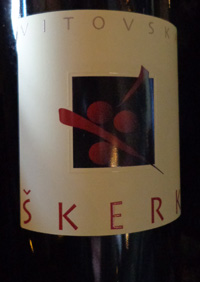 2011 Skerk, Vitavska, Friuli-Venezia Giulia, Italy.
2011 Skerk, Vitavska, Friuli-Venezia Giulia, Italy.
Sandi Skerk’s Vitovska is a lovely and brisk white, even if technically an “Orange” wine, it shows just a hint of pale yellow and flows vibrantly in the glass, I’d certainly enjoy this wine with oysters! The delicate aromas and sizzling acidity keeps this bright, tangy and fresh throughout, though it gains depth and density with air, best not to serve too cold, cellar temp is best and makes a huge difference. As this wine unfolds it really comes alive with savory elements, mineral and richer fruit notes with tangerine, melon and lemon zest. The Vitavska grape is found only here and is a purely unique example of region, terroir and winemaking, the long maceration on the skins doesn’t bring much orange/pink color, but certainly the skins impart character, spice and tannins making for a gripping wine. Very interesting, though not as pleasing as the Malvasia or the Ograde in the collection from Skerk, both of which are more graceful than the Vitavska alone anyway.
($35 Est.) 88 Points, grapelive
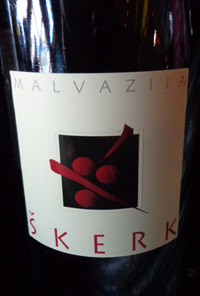 2010 Skerk, Malvazija (Malvasia Istriana) Friuli-Venezia Giulia, Italy.
2010 Skerk, Malvazija (Malvasia Istriana) Friuli-Venezia Giulia, Italy.
Sandi Skerk’s 2010 Malvazija is stunningly fresh and beautiful with impressive depth, elegance and life, for an orange wine it is delicate, vivid and crisp, not what I was expecting, but was gifted with a happy surprise, this really is glorious and complex wine. With such long maceration, up to 40 days on the skins, I thought the color was not much different than a normal chardonnay in the glass and this vibrant and tangy Malvasia shows vigor and intensity without losing any charm or grace. The nose is clear with steely mineral tones, jasmine, citrus oil and orange pulp leading to a zesty palate of lemon/lime, tangerine, peach and marmalade with chalky dry spices, stones and bitter almond. This a profound white wine that showcases a region and style that needs to be taken much more seriously.
($40 Est.) 94 Points, grapelive
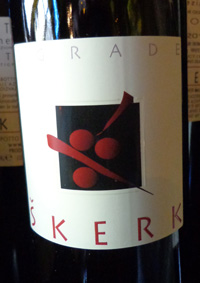 2011 Skerk, Ograde, Friuli-Venezia Giulia, Italy.
2011 Skerk, Ograde, Friuli-Venezia Giulia, Italy.
A proprietary white blend of Vitavska, Pinot Grigio, Sauvignon Blanc and Malvasia is real Orange wine that shines pink/orange in the glass and tastes fresh and lively, the Skerk hallmark, this is lovely and compelling wine. This cloudy and dense dry wine feels light on it’s feet with bright and zesty aromas and flavors with tangerine, citrus flowers, savory and salty spices, mountain herbs, apple skin, peach and persimmon. I had been expecting a tawny element, but none showed up, this is pure, vivid and fresh wine that makes you re-think your ideas of “Orange” wines, this is an ancient style of winemaking known from Italy to the Republic of Georgia, and the Skerk version is stable, tangy, clean and delicious. The color is from the Pinot Gigio which has pink/grey skins, the long maceration bleeds the orange/pink hue, Sandi Skerk claims between 15 and 40 days on the skins with this wine, though he adds that long skin contact doesn’t always mean more color in the Orange wine, he says some wines with only 10 or 14 days sometimes have a much darker color from the skins. This is totally drinkable and beautifully balanced wine that begs for food, cured meats, cheeses, seafood and almost anything that requires a dry wine would be super with this dynamic wine.
($40 Est.) 94 Points, grapelive
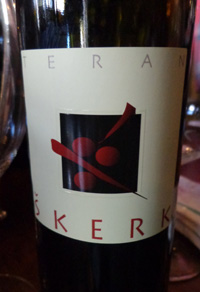 2011 Skerk, Terlan, Friuli-Venezia Giulia, Italy.
2011 Skerk, Terlan, Friuli-Venezia Giulia, Italy.
Slightly less dark than the Zidarich Teran I tried alongside and more structured than the Skerk 2010, the future release coming from Skerk the 2011 Teran is a tangy combination of sweet and sour flavors, spice and is a fine example of this grape and regional style with a slightly more elegant frame and more defined fruit. I would happily drink this wine almost anytime and enjoyed the play between the candied and sour mixed berry fruits and plum core. There is a pepper jelly and cracked pepper play too that is interesting as well to go with added elements of meat, mineral and kirsch notes that fold into the blackberry and bramble that comes through mid palate in this fun and vibrant wine. As mentioned the Teran grape is also known as Terrano in Italy and is off-shoot of the more well known Refosco varietal found in near by areas. Skerk, well respected for his “Orange” wines, certainly makes a good red too, drink young and enjoy the zesty freshness of this unique wine from the hills of Carso.
($35 Est.) 91 Points, grapelive